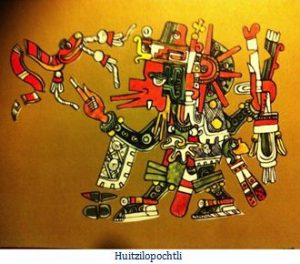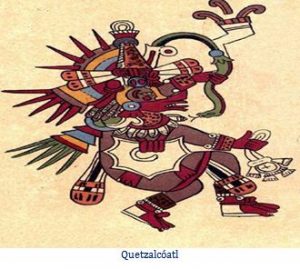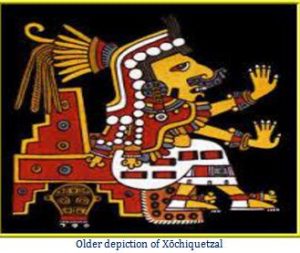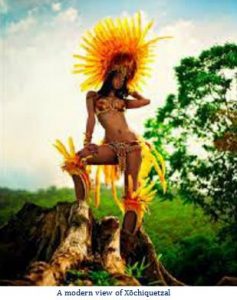By Kirby Vickery from the January 2016 Edition
Huitzilopochtli along with his ‘father’ and ‘brother,’ Quetzalcoatl (remembering the duality of most of the Aztec gods) were two of the most worshiped gods in Mexico, where he was associated with not only the Sun and War, but was the god of fertility and rain too.
Aztec gods) were two of the most worshiped gods in Mexico, where he was associated with not only the Sun and War, but was the god of fertility and rain too.
Rain and War God.
Huitzilopochtli is a common Nahua word that means “lord” or “owner.” The title was given to the local god of nearly every city in Mexico. Because of the importance of rain to life in the tropics of the Southern part of North America, these local gods were usually associated with war and the cycle of wet and dry seasons. Huitzilopochtli developed into a single widely known god, called Lord of the Earth and Lord of the Rain and Dew.
According to the tales, Tezcatlipoca, the sea god, demanded that Huitzilopochtli be made his slave. He sent messengers to Huitzilopochtli, asking him to surrender, but Huitzilopochtli attacked the messengers and drove them away. Huitzilopochtli then fought with Tezcatlipoca and, using two magic weapons [not identified in my source Ed], defeated him and seized control of the waters. In the story, Tezcatlipoca represents the destructive nature of water: rivers and seas flooding the land and ruining crops and killing animals. Huitzilopochtli represents water’s positive powers: rain and dew providing the moisture needed to make crops grow.
Huitzilopochtli’s Battle with Death.
 Other myths about Huitzilopochtli and Quetzalcóatl relate to fertility and the cycle of the seasons. One such story tells of the battle between Huitzilopochtli and Xipe Totec, the god of death and infertility. After conquering Tezcatlipoca, Huitzilopochtli complained that he had no house like the other gods did. Quetzalcóatl agreed to let the crafts god Kothar build Huitzilopochtli a fine house. When it was finished, Huitzilopochtli heald a great feast—but he did not invite Xipe Totec or send him respectful presents. Greatly insulted, Xipe Totec asked Huitzilopochtli to come to the underworld to dine.
Other myths about Huitzilopochtli and Quetzalcóatl relate to fertility and the cycle of the seasons. One such story tells of the battle between Huitzilopochtli and Xipe Totec, the god of death and infertility. After conquering Tezcatlipoca, Huitzilopochtli complained that he had no house like the other gods did. Quetzalcóatl agreed to let the crafts god Kothar build Huitzilopochtli a fine house. When it was finished, Huitzilopochtli heald a great feast—but he did not invite Xipe Totec or send him respectful presents. Greatly insulted, Xipe Totec asked Huitzilopochtli to come to the underworld to dine.
Although afraid, Huitzilopochtli could not refuse the invitation. The food served at Xipe Totec’s table was mud, the food of death, and when Huitzilopochtli ate it, he was trapped in the underworld.
While Huitzilopochtli was in the underworld, famine struck the land, and Quetzalcóatl searched for someone to replace Huitzilopochtli.
Meanwhile, Huitzilopochtli’s wife and sister, the fierce goddess of love, Xōchiquetzal, traveled to the underworld. After splitting Xipe Totec with her sword, she winnowed him with her fan, burned the pieces in a fire, ground them in a mill, and planted them in the ground. These actions brought Huitzilopochtli back to life.
Later Xipe Totec was also restored to life, and the two gods again battled each other. In the end, the sun  god Quetzalcóatl separated them, Huitzilopochtli regained his throne, and the land became fertile again.
god Quetzalcóatl separated them, Huitzilopochtli regained his throne, and the land became fertile again.
Like the story of Tezcatlipoca, this myth emphasizes the importance of rain to the land. Huitzilopochtli represents the fertility of spring rains, while Xipe Totec represents the drought of the summer months. The actions taken by Xōchiquetzal against Xipe Tote splitting, winnowing, burning, grinding, and planting are steps taken by farmers when they harvest small grains. They prepare it for use as food during the winter and sow it to create more crops the next year. By defeating the drought (Xipe Totec), the rains (Huitzilopochtli) renew the earth each year and allow life to flourish in all of Mexico.
[To the reader: If the above doesn’t seem to sit quite right in your Aztec mythology corner, then ya’ got me. I sorta made it up. Well, even that’s not right. I changed the names and locations from another culture’s mythological story, with Ian’s permission, and printed it up here as Aztec mythology. What happened was  when I first started to run this in the Manzanillo Sun in 2013, I noticed a lot about their civilization and how it was held together. There was a ‘Priest Class’ and for better or worse everything hinged on the human sacrifice. It was all about blood, comma, tree and plant sap, comma, life giving water. There’s the tie in and the priests worked so hard that there is documentation that shows that Aztec people would rather be sacrificed than to die any other way. I thought this as overly bloody. But what I have discovered is that most of the different mythologies are all bloody and gory, although most didn’t go into the sacrifice that much but still got into the killing and descriptive bloodletting battles. So I borrowed one and converted it. So as to not incur the wrath of the readership I will send a whole dollar (USD) to the first person that can pin point the real mythology and major god depicted here with Ian being the judge. — Kirby Vickery, Ed.]
when I first started to run this in the Manzanillo Sun in 2013, I noticed a lot about their civilization and how it was held together. There was a ‘Priest Class’ and for better or worse everything hinged on the human sacrifice. It was all about blood, comma, tree and plant sap, comma, life giving water. There’s the tie in and the priests worked so hard that there is documentation that shows that Aztec people would rather be sacrificed than to die any other way. I thought this as overly bloody. But what I have discovered is that most of the different mythologies are all bloody and gory, although most didn’t go into the sacrifice that much but still got into the killing and descriptive bloodletting battles. So I borrowed one and converted it. So as to not incur the wrath of the readership I will send a whole dollar (USD) to the first person that can pin point the real mythology and major god depicted here with Ian being the judge. — Kirby Vickery, Ed.]
Download the full edition or view it online
—
Kirby was born in a little burg just south of El Paso, Texas called Fabens. As he understand it, they we were passing through. His history reads like a road atlas. By the time he started school, he had lived in five places in two states. By the time he started high school, that list went to five states, four countries on three continents. Then he joined the Air Force after high school and one year of college and spent 23 years stationed in eleven or twelve places and traveled all over the place doing administrative, security, and electronic things. His final stay was being in charge of Air Force Recruiting in San Diego, Imperial, and Yuma counties. Upon retirement he went back to New England as a Quality Assurance Manager in electronics manufacturing before he was moved to Production Manager for the company’s Mexico operations. He moved to the Phoenix area and finally got his education and ended up teaching. He parted with the university and moved to Whidbey Island, Washington where he was introduced to Manzanillo, Mexico. It was there that he started to publish his monthly article for the Manzanillo Sun. He currently reside in Coupeville, WA, Edmonton, AB, and Manzanillo, Colima, Mexico, depending on whose having what medical problems and the time of year. His time is spent dieting, writing his second book, various articles and short stories, and sightseeing Canada, although that seems to be limited in the winter up there.





You must be logged in to post a comment.